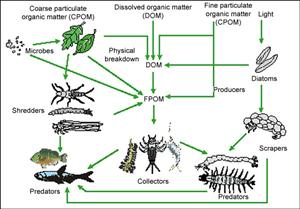Food Chains and Food Webs
The energy and matter produced by plants and other autotrophs are distributed to other organisms in an ecosystem through pathways known as food chains and food webs.
A food chain is a simple linkage of producers to consumers through feeding relationships. For example, when a small fish eats an aquatic insect, and a larger fish eats the small fish, the two fish and the insect are linked in a food chain.
Food webs are more complex, and consist of a network of linked food chains. Organisms commonly consume, and are consumed by, more than one other type of organism. Each organism has characteristic feeding preferences and patterns, and can itself be prey to other consumers. Food webs connect autotrophs, at the lowest feeding level, to the herbivores (primary consumers) and then to various carnivores (secondary consumers). A simplified view of a food web in a wooded stream is presented on the right. The concept of food webs is also demonstrated in the Food Web interactive feature .
The trophic level is an organism's position in the food chain as determined by the number of energy-transfer steps required to reach that level (Begon et al.1990). A fish that has consumed an insect, which itself has just consumed algae, is at a higher trophic level than the insect.
In rivers, as in the majority of other aquatic and terrestrial systems, the energy at the base of a food web comes from the solar energy fixed by plants (through photosynthesis) growing in the water or on land.
Energy derived from terrestrial plants enters the water in the form of plant parts, such as leaves or twigs, or in the form of dissolved organic matter. This material is used as a source of energy by microorganisms such as fungi and bacteria, and by invertebrates. Plants in the river are also important in food webs—microscopic algae are often eaten while alive, while larger aquatic plants mainly enter food chains after they have died.
Cascade interactions occur in food webs when one group of organisms indirectly affects another group, by feeding on animals that eat the other group. For example, when predators consume herbivores, the plants that the herbivores would otherwise have consumed will multiply. Because of the complex interactions, change to the structure of a food web by introducing or removing species, can have unpredictable results. Looking at ecosystems in terms of food chains and webs, however, can help us understand how species introduction or removal impacts the environment.









